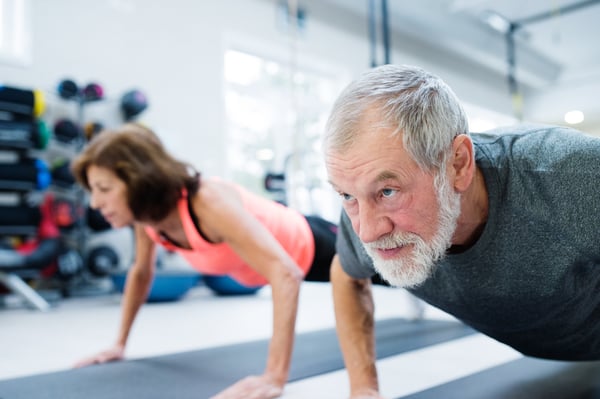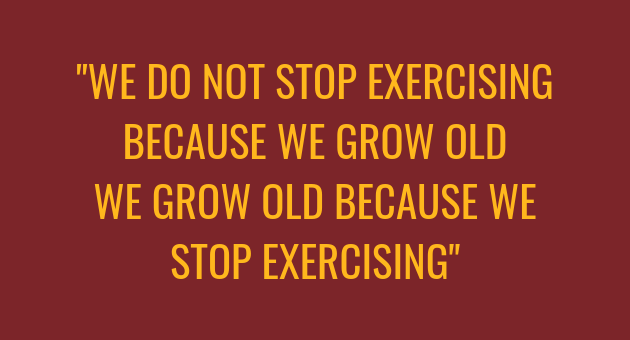Exercising At Every Age: Does Your Age Determine Your Workout?

The very day after I turned 40, I started to see articles everywhere like “Exercises to Never Do After 40” and “Top Ways to Build Muscle After 40” or “What is The Best Workout For Women Over 40?”. I received emails, saw ads on websites and spotted magazine articles all with the big 4-0 in the title.
How the internet knows how to specifically target you based on your age is a very scary thing that could be the subject for another type of blog post, but we will just focus on the fitness aspect of this type of information here.
Kidding aside, we are bombarded with these messages that once we are past a certain age we can no longer do particular workouts or exercises. The things I was doing in my workout the day before at 39, I shouldn’t do the next day because I’m 40 (gasp)? Should someone who is 60 or 70 not start exercising? Are the exercises appropriate for a 20 year old not right for someone who is 65? Does age really matter?
Your Body As You Age
I’ve met with someone who is in great shape at 81 and can hold a 7-minute plank (no lie). I’ve also met with someone who at age 32 cannot hold a 10-second plank (also true).
Age is not necessarily a factor when it comes to fitness level. Everybody’s body and lifestyle are different which affects the type of workouts that are most appropriate for you. Age doesn’t matter as much as your particular stage of fitness and health.
That being said, there are some changes that your body goes through as you get older that can affect the workout that is best for you, but also makes exercise even more important than when you were in your 20s and 30s.
Bone mass peaks around age 30. Bone resorption begins to exceed new bone formation in your 30s and slowly leads to bone loss. Osteoporosis is a disease characterized by low bone mass and is a leading cause of bone fractures in women over the age of 50 (National Institute of Health for Osteoporosis and Related Bone Diseases National Resource Center, 2015).
Though osteoporosis is not typically diagnosed until later in life, the bone loss process starts earlier. Strength training and weight bearing activities will help offset this bone loss and strengthen bones. Women especially suffer from bone loss. Strength training, either with body weight or weights, is beneficial to do at any age. But to specifically help prevent osteoporosis, it is best to start in your 20s and 30s.
Beginning in your 30s, your natural muscle mass and strength will start to decline (unless you do something about it!). The less muscle you have, the lower your metabolism, which may cause weight gain.
It also can contribute to joint pain, back pain, as well as other physical ailments. However, this does not have to happen.
An exercise routine with strength and resistance training beginning in your 20s and 30s can combat the extent of any muscle loss. Are you in your 40s or beyond and have never had a workout routine with any type of weight training?
Don’t worry, incorporating any weight training and weight bearing activities at any age can help to maintain your muscles.
In our 40s, both men and women start to experience dropping hormone levels.
This makes it easier to gain weight, especially the most dangerous type of fat around our middle, visceral fat.
This type of weight increases the risk of other health conditions such as; high blood pressure, diabetes and heart disease.
This can happen at any age, however, it is more likely a little later in life due to the changes in our hormones.
A consistent exercise routine and a healthy diet can fight all of these changes.
Balance becomes more challenging and reaction time slows as we age which contributes to falls.
The Center of Disease Control and Prevention reported that one out of four people over the age of 65 experience a fall each year. Combined with bone loss, this results in many broken hips and other bones.
Balance training should be a part of all exercise routines for anyone, especially those over the age of 65, to reduce the risk of falls.

This is not a comprehensive list of the things our bodies go through as we age, but highlights some of the most prevalent changes and those that can be improved or prevented by exercise.
Certainly our bodies start to wear with use, which may result in more aches and pains and make exercise feel more difficult.
But that is more reason to keep moving! Kenneth Cooper, MD is attributed as saying, “We do not stop exercising because we grow old – we grow old because we stop exercising…”.
Benefits of Exercise When You Are Older
Some think that it is too late to start exercising at a certain point because physical decline as you age is inevitable or they feel they are too out of shape, are in too much pain or just plain too old to exercise.
That couldn’t be farther from the truth. Physical activity will be good for anyone at any age or fitness level. Exercise can help make you stronger, prevent bone loss, improve balance and coordination, lift your mood, boost your memory, and ease the symptoms of many chronic conditions. Many symptoms we associate with old age, such as muscle weakness and loss of balance, are made worse by inactivity.
It’s never too late to start. Improvements to one’s physical health can be made at any age. Studies have shown that people in their 90s who started an exercise routine for the first time built muscle strength.
Other research shows that starting exercising later in life still cuts the risk of health problems and improves symptoms of any ongoing issues.
What if you have never worked out before? Starting a new workout routine should be entered into slowly and with consideration. Ease into it and build from there to help avoid potential injuries. This is true for any age!
Should Your Workout Change As You Age?
I mentioned I started seeing articles about exercising for those over 40 the very day after my 40th birthday. One specifically was about the exercises you shouldn’t do after that age.
Should you not do certain exercises after a certain age? Not necessarily. Fitness level and any injuries you may have are more important than age when it comes to exercise selection.
For example, high impact moves (like those that involve jumping) should be avoided by anyone with knee replacements or certain knee injuries. A 25 year old could have knee injuries and a 70 year old might as well.
Both persons should avoid the high impact exercises and modify to the low impact version.
As you get older, your body does have a bit more wear and tear. You may notice you don’t bounce back as easily from a tough workout or injury as you may have done in your 20s or 30s.
You may start to experience more aches and pains. A proper warm up prior to exercising and a good stretching routine is always beneficial for anyone, but is even more important as we age.
Also, in your 40s and beyond you should be even more considerate about your form and any previous injuries.
A recent New York Times article profiled Julia Hawkins, a 103 year old who ran the 50 and 100 meter dash at the National Senior Games this year.
She set the 50 meter dash record when she was 101 after taking up running the year before when she was 100!
Hawkins previously competed in the Senior Games in biking. She only started running when biking became too difficult for her.
Her secret to longevity, “To stay in shape, just keep active”. I love her story and it shows that you don’t have to stop being active at any age.
You may need to adjust your type of workout, but there is always something you can be doing to keep moving.
Working Out with Chronic Conditions
Those with arthritis or other painful conditions may feel they are in too much pain to exercise. It doesn’t seem like it makes sense, but the more you move, the better you will feel.
A study of people over 60 with arthritis in their knee (or knees) found that those who exercised more had less pain and better joint function.
Keeping the muscles and surrounding tissues strong is crucial to maintaining support for your joints and bones. Weak muscles create more stress on your joints.
Any movement, no matter how small, can help. Daily activities such as mowing the lawn, walking the dog or raking leaves make a difference.
Your doctor, physical therapist or personal trainer can recommend particular exercises for your condition. If you are taking a group exercise class, let the instructor know prior to class about your situation. They can provide you with the appropriate version of each exercise.
Bottom line, exercising is important for your health for your entire life. Our bodies do change as we grow older, but exercise is the key to minimize any resulting health conditions or potential illnesses.
There is no magic birthday that is the day for everyone that they have to stop doing one type of workout and must do another, or need to get out a rocking chair and call it a day.
Modify your workout routine based on your fitness level and physical condition, not your age. Make it a priority so you can stay active, independent, healthy and happy for the rest of your life.


